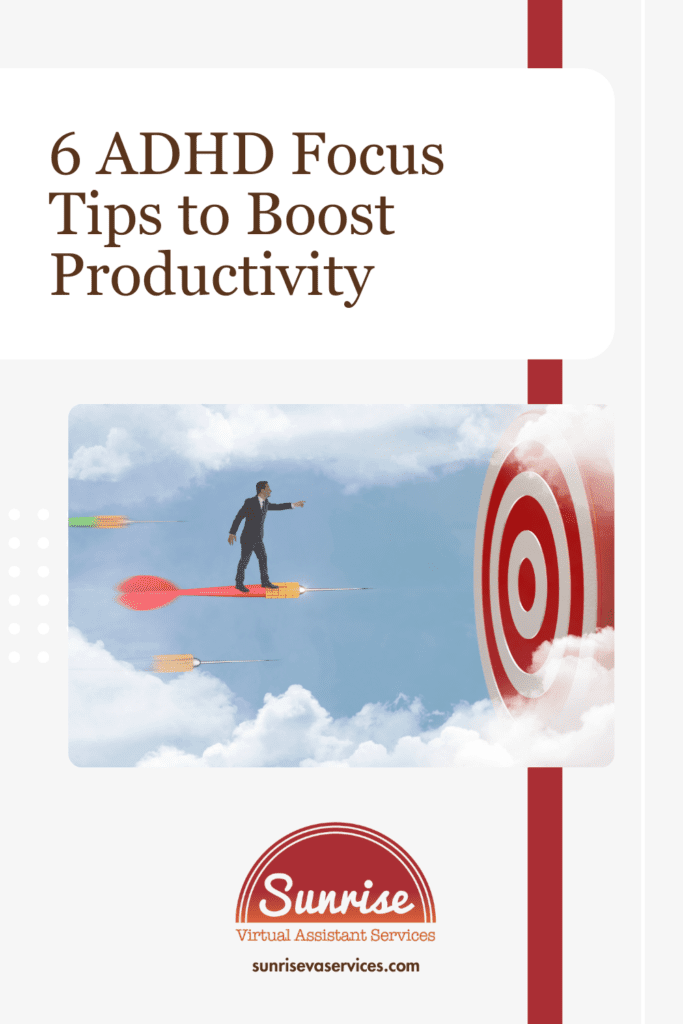Living with ADHD (Attention Deficit Hyperactivity Disorder) comes with unique challenges; particularly, when it comes to productivity. The ADHD brain is constantly battling lower levels of dopamine, frequent distractions, and difficulty prioritizing tasks.
These hurdles can make it tough to get started on important tasks or to sustain attention long enough to complete them. The good news? With the right strategies, you can work with your brain, rather than against it, to improve focus, manage tasks, and accomplish goals.
Whether you’re a small business owner trying to juggle client deadlines or an individual struggling to stay on top of daily tasks, these six ADHD focus tips can become game-changers for boosting productivity.
1. Use the Pomodoro Technique to Structure Work and Breaks
The Pomodoro Technique is one of the most effective time management strategies for adults with ADHD to stay focused. The idea is simple—break your work into short, manageable steps using specific time blocks. You set a timer for a set amount of time, usually 25 minutes of work (a Pomodoro), followed by a 5-minute break.
Why is this helpful for ADHD?
The ADHD brain craves novelty and stimulation, which can make sustained focus on tedious tasks difficult. The Pomodoro method injects breaks between work periods, giving your brain the stimulating variety it needs to stay engaged. A 5-minute break can be an excellent reset for those overwhelmed by big projects or important deadlines.
Pro Tip
Use a timer app, such as Focus Keeper, or an ADHD-friendly task management app that incorporates the Pomodoro method to track your work intervals seamlessly.
2. Create a Clutter-Free Workspace to Limit Distractions
Your overall work environment influences your ability to stay focused. External distractions like visual clutter and noise can pull your attention away. Create a clutter-free workspace that promotes focus by using these practical strategies:
- Clear off unnecessary items from your desk. Stick to the essentials, like sticky notes, your day planner, and a small stress ball or fidget toy.
- Minimize visual distractions by having a simple, clean background.
- Invest in noise-canceling headphones or play white noise or focus-friendly music in the background. For some, listening to subtle background tunes can engage the ADHD mind, improving attention levels.
Whether you’re in a busy coffee shop or your home office, building an environment catered to reducing external distractions can help you stay on track.
3. Leverage Digital Tools and Task Management Apps
For individuals with ADHD, organizing an overwhelming to-do list feels like climbing a mountain. This is where technology can lend a helping hand. Tools like task management apps and digital planners make time management more straightforward and more effective.
Here’s how to use them effectively for ADHD productivity:
- Break large tasks into smaller steps or specific tasks using apps like Todoist or Trello. This prevents that feeling of being frozen by the enormity of a big project.
- Use visual aids like color-coded labels or reminders for important deadlines and daily to-do lists.
- Schedule specific times for your daily tasks using a calendar so you allocate enough time to complete each without feeling rushed.
By having all your tasks in one place with clear visual reminders, you can regain control over your daily life and minimize procrastination.
4. Incorporate Regular Physical Activity for Better Focus
Regular physical activity isn’t just great for your physical health; it’s an excellent way to improve cognitive function and focus. Physical exercise helps regulate your brain chemistry, increasing dopamine and norepinephrine levels, which are essential for maintaining attention.
Here are some ADHD-friendly tips to work movement into your day:
- Start your morning with short cardio time (even a 10-minute walk can make a difference).
- Use your breaks during the day to do deep breathing exercises or stretch.
- Consider using fidget toys or a stress ball while working to channel excess energy.
Physical activity doesn’t have to mean an intense gym workout. Even low-impact movement, like yoga or dancing, can help you focus on what matters most.
5. Practice Mindfulness and Meditation
Taming an ADHD mind means finding ways to calm racing thoughts and improving executive function skills. Mindfulness meditation is one of the best ways to help you develop attention control and reduce impulsive behavior over time.
Here are ways mindfulness can make a difference for ADHD brains struggling with a lack of focus or internal distractions:
- Start small with a 3-to-5-minute meditation session daily.
- Use guided meditation apps like Headspace or Calm to ease into the practice.
- Pair it with skills like deep breathing to focus and manage stress.
Over time, mindfulness can enhance your ability to focus on specific tasks for more extended periods and improve mental clarity.
Pro Tip
If meditation feels hard to stick with, other soothing activities like coloring, knitting, or journaling can achieve similar benefits by engaging the prefrontal cortex and reducing symptoms of inattention.
6. Seek Professional Guidance and ADHD-Friendly Strategies
While practical tips and tricks can make a big difference, sometimes managing Adult ADHD requires professional insight.
A qualified healthcare provider or therapist can guide you through tailored approaches, such as cognitive behavioral therapy, to address challenges like impulsive behavior or time management.
Key areas where professional guidance is invaluable include:
- Learning to work with ADHD symptoms, such as organizing daily tasks and reducing overwhelm.
- Managing executive function skills more effectively, allowing for consistent productivity.
- Providing tools for handling emotional support and improving communication with your family members or coworkers.
ADHD strategies vary among different people, so finding what works for your unique brain is key to success.
Bonus Tip – Allocate Time for Enough Sleep
Sleep is foundational for focus and productivity, yet many with ADHD struggle with getting enough sleep. A poor night’s rest can amplify symptoms of ADHD, making it even harder to focus, prioritize, and complete tasks.
Build a routine that prioritizes rest, and avoid excessive screen time before bed to create the conditions for quality sleep.
Final Thoughts on ADHD Focus Tips
Each ADHD brain handles tasks differently, and productivity isn’t one-size-fits-all. The most effective strategies consider the unique challenges of ADHD and focus on practical solutions that work for you.


